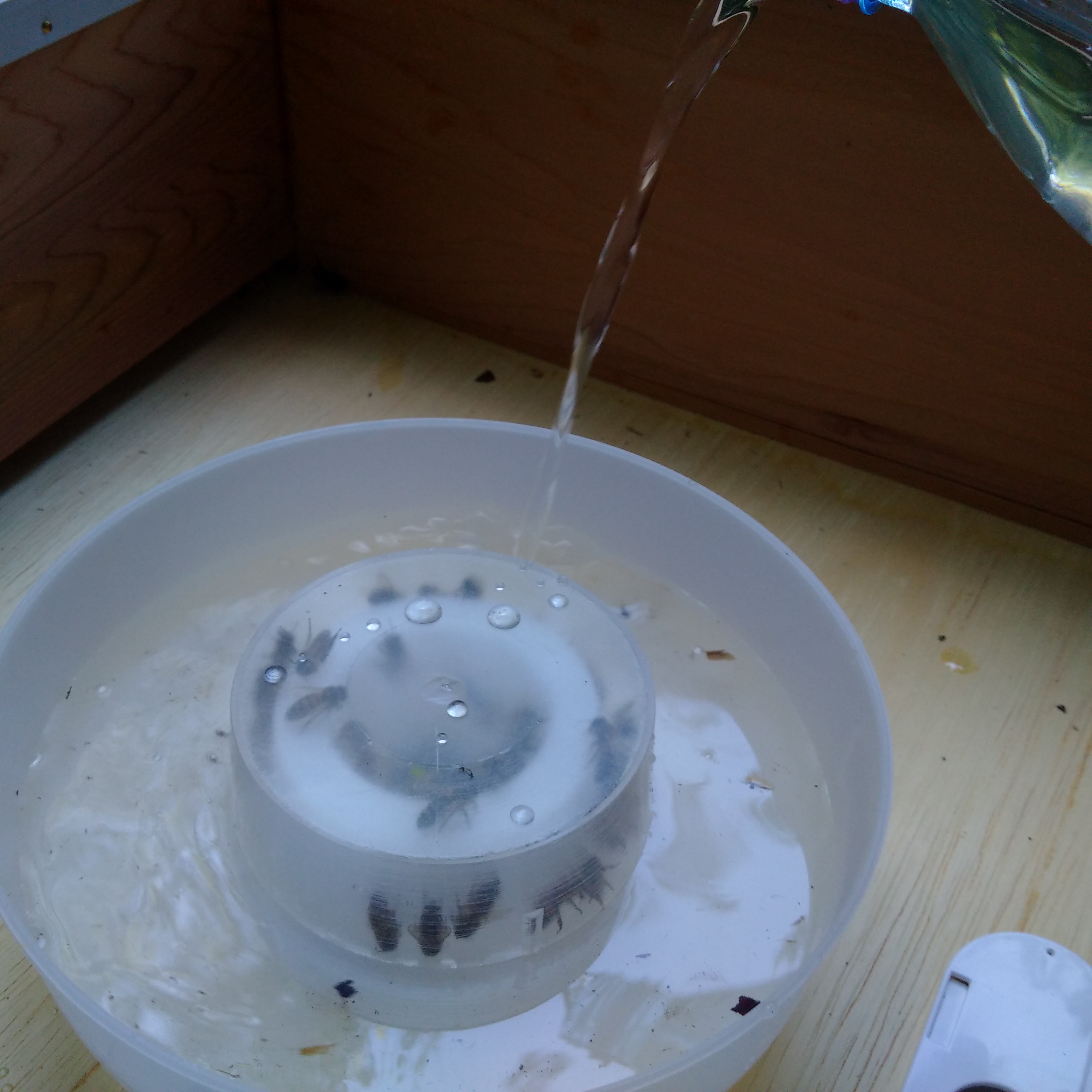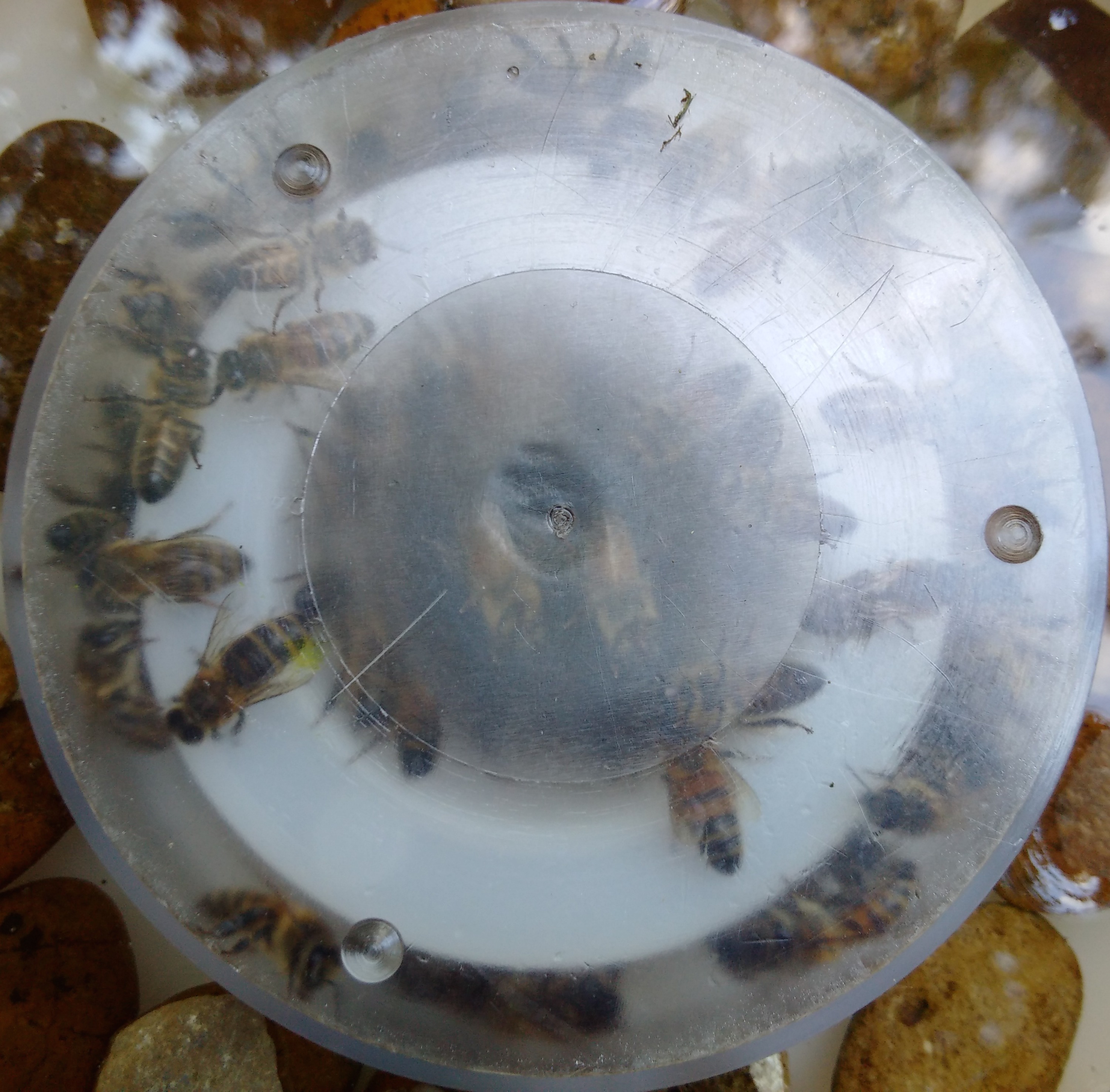To start with something worth saying:
**Do not feed bees honey. **If you find a tired bee, mix it up some sugar solution. One crystal of caster sugar to one drop of water should do. Honey from the shops, which is usually from a foreign country, and even honey from a more local hive can contain fungal spores which can cause serious diseases, like American Foul Brood.
Now that’s over, let’s move from feeding individual bees to the feeding of tens of thousands.
In my post on the installation of a nucleus I showed the improvised bottle contact-feeder in action.
 After making a mistake, too many holes in the bottle and some of my bees a bit more syrupy than they had expected to get when they awoke that morning, I settled with poking a couple of holes in the lid of the bottle. This meant that only two or three bees could feed at once.
After making a mistake, too many holes in the bottle and some of my bees a bit more syrupy than they had expected to get when they awoke that morning, I settled with poking a couple of holes in the lid of the bottle. This meant that only two or three bees could feed at once.
Not ideal, as they need all the food they can get at the moment. This all being new to me, I didn’t know how much food they could get through. After all, a never-ending supply of nectar-substitute right in their home was surely worth a hundred flowers?
I checked back on them after a day and the level in the bottle had dropped maybe a few millimetres. It’s obvious they were having trouble making full use of the syrup.
Not to worry, as my proper rapid feeder arrived soon enough! It’s a plastic toroidal thing, with a reservoir to keep syrup in. The feeder goes inside the hive and the bees go inside the feeder. It has nice bee-friendly slopes to allow feeding, and an almost-window to look through.

And no, I’m not particularly proud of that pouring technique.
So what
So what happens when you provide bees with a large supply of refined sugar? About the same thing that would happen if you did the same with a child, except, I hope, without dooming it to a life of diabetes. They become darling little maniacs.
It seems obvious that the introduction of a circular space should induce bees to go round it in circles, and that’s what the first bee did, but somehow it surprised me. It ran round in circles for the best part of a minute before it was joined by other bees, who ran round in circles for the best part of a minute. They then noticed the food, settled down, and started feeding.
This settling down didn’t last long. I have seen somewhere in the literature that when bees drink syrup they ‘become excited’. This couldn’t be a truer description of what happened.
Ancestors
I have come across large numbers of bees in my life, and it’s these individual encounters that have drawn me to them. These bees, whether solitary or social, honeybee or bumblebee have always been out foraging. This involves spending as little energy as possible trying to locate as much energy as possible. I know their careful movements, occasional protective body language and, in some species' case, utterly hopeless flying.
But seeing these bees in the feeder revealed an entirely new side. As they became, shall we say, excited, no longer out in public, with unlimited energy to burn, they started to throw their weight round a bit. They started stamping and running around and making themselves heard. And they were walking upside down so I was looking at their underneaths.
These erstwhile gentle and delicate animals (although occasionally irritated and able to sting) started to swagger in a very familiar way. The characteristic acceleration and movement of their legs with a slight jerk. I was looking at a cousin of wasps. The limbs put me in mind of ants and even of cockroaches.
For a moment I felt like I no longer knew who these creatures were. Their movement was so familiar to me but in connection to animals I considered radically different. I am indifferent to ants, I have the usual reaction to cockroaches.

It’s disorienting to see the familiar become unfamiliar and to form new connections between disconnected things.
But bees is bees, and insects is insects, and bees is insects and some insects is bees. And I love them all the same, and I’m sure if I gave any insect a litre of sugar juice it would do much the same thing.
They kept the pace up. That feeder was empty within a day.
